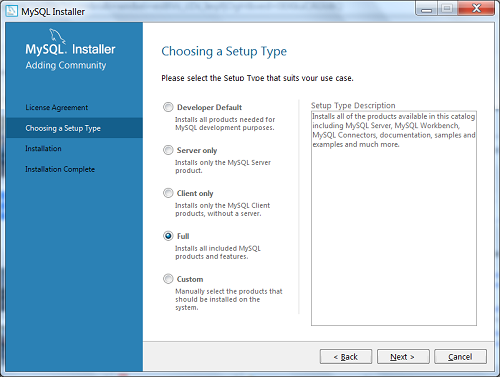MySQL Tutorials - Herong's Tutorial Examples - v4.46, by Herong Yang
Downloading and Installing MySQL
A tutorial example on how to download and install MySQL on a Windows system using MySQL Installer.
1. Go to MySQL download Website at dev.mysql.com/downloads and click on the "Community (GPL) Downloads" in the "MySQL Community Edition" section. The "MySQL Community Downloads" page shows up.
2. Click the "MySQL Community Server (GPL)" link. The "Download MySQL Community Server" page shows up.
3. Select "Microsoft Windows" as the Operating System and click "Go to Download Page" button. The "Download MySQL Installer" page shows up.
4. Click the "Download" button next to "Windows (x86, 32-bit), MSI Installer 8.0.16 373.4M (mysql-installer-community-8.0.16.0.msi))". "Begin Your Download - mysql-installer-community-8.0.16.0.msi" page shows.
5. Click the "No thanks, just start my download." link to skip the login process. The download process starts.
6. Save the downloaded file, mysql-installer-community-8.0.16.0.msi, to the \temp folder.
7. Double-click on \temp\mysql-installer-community-8.0.16.0.msi to start installation. Follow the installation instruction until you see the "MySQL Installer" window shows up.
8. Accept the term and condition and click the "Next" button to continue installation.
9. Select "Full" on the "Choosing a Setup Type" screen and click the "Next" button to continue installation.
10. Enter "TopSecret" as the administrator password when prompted and click the "Next" button to continue installation.
11. Follow instructions and taking default settings to finish the installation.

Table of Contents
►MySQL Introduction and Installation
►Downloading and Installing MySQL
Issues during MySQL Installation
Starting and Stopping MySQL Server
MySQL Command Line Client Tool
Using MySQL Non-Install Package
MySQL Data Directory Initialization
Creating MySQL Windows Service
%mysql% Variable for MySQL Server Path
Introduction of MySQL Programs
Perl Programs and MySQL Servers
Java Programs and MySQL Servers
Character Strings and Bit Strings
Table Column Types for Different Types of Values
Using DDL to Create Tables and Indexes
Using DML to Insert, Update and Delete Records
Using SELECT to Query Database
Window Functions for Statistical Analysis
Use Index for Better Performance
Transaction Management and Isolation Levels
Defining and Calling Stored Procedures
Variables, Loops and Cursors Used in Stored Procedures
System, User-Defined and Stored Procedure Variables
Storage Engines in MySQL Server
InnoDB Storage Engine - Primary and Secondary Indexes
Performance Tuning and Optimization
Installing MySQL Server on Linux